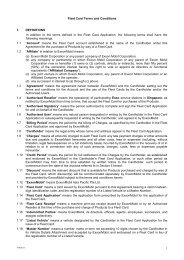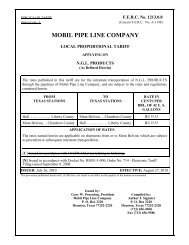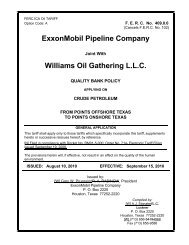2012 — Number 1 - ExxonMobil
2012 — Number 1 - ExxonMobil
2012 — Number 1 - ExxonMobil
Create successful ePaper yourself
Turn your PDF publications into a flip-book with our unique Google optimized e-Paper software.
The hands-on<br />
course covers<br />
risk management,<br />
employee and public<br />
safety, government<br />
relations and<br />
practical incidentresponse<br />
training.<br />
that, to be useful, the training<br />
must include both classroom<br />
instruction and hands-on experience.<br />
The hands-on component<br />
is critical because it drives home<br />
the lesson that theory and reality<br />
don’t always mesh.”<br />
Training sessions began<br />
in 2009, and more than 400<br />
employees have participated<br />
so far. Most sessions are conducted<br />
at a dedicated company<br />
training facility in Paradis,<br />
Louisiana, about 20 miles south<br />
of New Orleans.<br />
Training goes global<br />
Initial classes focused on<br />
employees in the United States<br />
and Canada, including classes<br />
on Arctic response that were<br />
held in Canada. This year,<br />
Tomblin and Hansen are taking<br />
their training to <strong>ExxonMobil</strong><br />
employees in Singapore,<br />
Australia, Russia (Sakhalin)<br />
and the United Kingdom.<br />
Participants come from all<br />
areas of the company, including<br />
exploration, production, refining,<br />
marketing, pipeline and tanker<br />
operations. Attendees range<br />
from lead country managers to<br />
technicians.<br />
“We’re not training any one<br />
person to be an expert in any<br />
one thing,” explains Tomblin. “We<br />
train them to be part of an overall<br />
incident-management team. We<br />
want them to understand the<br />
expectations that will be placed<br />
on such a team. Everyone<br />
affected by an oil spill or other<br />
incident will have demands. This<br />
includes local citizens, government<br />
agencies, elected officials,<br />
the news media, other businesses<br />
that may be affected and<br />
so on. We try to give participants<br />
the big picture so they’ll understand<br />
the wide range of issues<br />
they will face when they serve on<br />
an incident-management team.”<br />
Classroom instruction includes<br />
presentations by subject-matter<br />
experts on such topics as hazard<br />
recognition, spill containment<br />
and recovery, protective<br />
equipment, decontamination<br />
procedures, environmental sensitivities,<br />
oil-spill behavior and<br />
effects, risk management, news<br />
media relations, government<br />
affairs and use of dispersants.<br />
Exposure to these topics gives<br />
participants a broad understanding<br />
of the many facets involved<br />
in managing a response.<br />
When theory meets reality<br />
Two days of classroom sessions<br />
are followed by a day of outdoor<br />
hands-on training deploying<br />
oil-spill response equipment.<br />
It’s here that participants learn<br />
firsthand that theory and reality<br />
often conflict.<br />
“In real-world deployment, terrain,<br />
weather and operating conditions<br />
can vary widely, and can<br />
change quickly,” says Hansen.<br />
“In the classroom, we explain<br />
how booms, skimmers and<br />
other equipment are designed<br />
to work. Then we go out on the<br />
water and deploy that equipment.<br />
Participants see firsthand<br />
that conditions can change<br />
quickly. Factors such as rough<br />
seas, changing tides, high winds<br />
and freezing temperatures can<br />
complicate the best of plans.”<br />
Hansen recalls a recent session<br />
involving placement of<br />
a long string of containment<br />
boom. “At 9 a.m., everybody<br />
was enthusiastic about getting<br />
that boom into the water. But<br />
by noon, they had an understanding<br />
for how difficult it can<br />
be. Doing it<br />
themselves<br />
was the<br />
best way for<br />
To learn more<br />
exxonmobil.com/<br />
emergencyresponse<br />
them to learn that laying boom<br />
is a physically demanding and<br />
complex task. From an incidentmanagement<br />
perspective, that’s<br />
an extremely important lesson.”<br />
“Of course, we hope our<br />
students never have to use the<br />
knowledge and skills we give<br />
them,” Tomblin adds. “But if they<br />
do, we know that every one of<br />
them is capable and will do the<br />
right thing if called upon.” the Lamp<br />
12

















